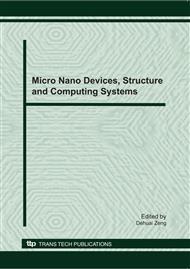[1]
Z. Zhang, H. Chen, J. Zhong, Y. Chen and Y. Lu, in: Proceedings of the 2006 IEEE International Frequency Control Symposium and Exposition, edited by Institute of Electrical and Electronics Engineers ( IEEE, 2006 ), Vol. 2, pp.545-549.
Google Scholar
[2]
A. Akyol, H. C. Yatmaz and M. Bayramoglu: Appl. Catal. B: Environ. Vol. 54 (2004), p.19.
Google Scholar
[3]
B. Baruwati, D. K. Kumar and S. V. Manorama : Sens. Actuators B, Vol. 119 (2006), p.676.
Google Scholar
[4]
K. Keis, E. Magnusson, H. Lindstrom, S. E. Lindquist and A. Hagfeldt : J. Photochem. Photobiol., A, Vol. 148 (2002), p.57.
Google Scholar
[5]
S. Singh, P. Thiyagarajan, K. M. Kant, D. Anita, S. Thirupathiah, N. Rama, B. Tiwari, M. Kottaisamy and M. R. Rao : J. Phys. D: Appl. Phys. Vol. 40 (2007), p.6312.
DOI: 10.1088/0022-3727/40/20/s15
Google Scholar
[6]
M. H. Huang, Y. Wu, H. Feick, N. Tran, E. Weber and P. Yang: Adv. Mater. Vol. 13 (2001), p.113.
Google Scholar
[7]
Z. W. Pan, Z. R. Dai and Z. L. Wang: Science, Vol. 291 (2001), p. (1947).
Google Scholar
[8]
J. Y. Li, X. L. Chen, H. Li, M. He and Z. Y. Qiao: J. Cryst. Growth, Vol. 233 (2001), p.5.
Google Scholar
[9]
Y. Tseng, C. Huang, H. Cheng, I. Lin, K. Liu and I. Chen: Adv. Funct. Mater. Vol. 13 (2003), p.811.
Google Scholar
[10]
M. S. Kumar, T. Y. Kim, J. Y. Kim, E. K. Suh and K. S. Nahm: Phys. Stat. Sol. Vol. 1 (2004), p.2554.
Google Scholar
[11]
L. Vayssieres: Adv. Mater. Vol. 15 (2003), p.464.
Google Scholar
[12]
T. Sekiguchi, S. Miyashita, K. Obara, T. Shishido and N. Sakagami: J. Cryst. Growth, Vol. 214 (2000), p.72.
Google Scholar
[13]
D. W. Bahnemann, C. Kormann and M. R. Hoffmann: J. Phys. Chem. Vol. 91 (1987), p.3789.
Google Scholar
[14]
J. Jie, G. Wang, Y. Chen, X. H. Han, Q. Wang and B. Xu: Appl. Phys. Lett. Vol. 86 (2005), 031909.
Google Scholar
[15]
K. J. Huang, L. Yan and C. S. Xie: Mater. Rev. Vol. 24 (2010), p.7 (in Chinese).
Google Scholar
[16]
Z. Y. Wang, B. B. Huang, X. Y. Qin, X. Y. Zhang, P. Wang, J. Y. Wei, J. Zhan,X. Y. Jing, H. X. Liu, Z. H. Xu, H. F. Cheng, X. N. Wang and Z. K. Zheng: Mater. Lett. Vol. 63 (2009), p.130.
Google Scholar
[17]
J. Q. Xu, Y. Zhang, Y. P. Chen, Q. Xiang, Q. Y. Pan and L.Y. Shi; Mater. Sci. Eng. B, Vol. 150 (2005), p.55.
Google Scholar
[18]
P. Rai, S. K. Tripathy, N. H. Park, K. Joong, I. H. Lee and Y. T. Yu: J. Mater. Sci.: Mater. Electron. Vol. 20 (2009), p.967.
Google Scholar
[19]
F. Li, L. Hu, Z. Li and X.T. Huang: J. Alloy. Compd. Vol. 465 (2008), p.14.
Google Scholar
[20]
H. Zhang, D. R. Yang, Y. J. Ji, X. Y. Ma, J. Xu and D. L. Que: J. Phys. Chem. B, Vol. 108 (2004), p.3955.
Google Scholar
[21]
Y. X. Wang, X. Y. Fan and J. Sun: Mater. Lett. Vol. 63 (2009), p.350.
Google Scholar
[22]
Z. Z. Shao, X. A. Zhang, X. F. Wang and S. L. Chang: Spectrosc. Spectral Anal. Vol. 30 (2010), p.1257 (in Chinese).
Google Scholar
[23]
W. Y. Deng, Z. B. Zhao, L. Shen and J. S. Qiu: Funct. Mater. Vol. 38 (2007), p.1559 (in Chinese).
Google Scholar
[24]
Q. Zhou, Z. S. Zhang and H. Y. Li: Chin. J. Inorg. Chem. Vol. 22 (2006), p.1675 (in Chinese).
Google Scholar
[25]
A. Bera and D. Basak: Appl. Mater. interfaces, Vol. 1 (2009), p. (2066).
Google Scholar
[26]
S. Cho, H. Jeong, D. -H. Park, S. –H. Jung, H. –J. Kim and K. -H. Lee: Cryst. Eng. Comm. Vol. 12 (2010), p.968.
Google Scholar
[27]
D. Krishan and T. Pradeep: J. Cryst. Growth, Vol. 311(2009), p.3889.
Google Scholar
[28]
H. H. Wang and C. S. Xie: J. Cryst. Growth, Vol. 291 (2006), p.187.
Google Scholar
[29]
N. Han, Y. Tian, X. Wu and Y. Chen: Sens. Actuators B, Vol. 138 (2009), p.228.
Google Scholar
[30]
P. Lv, Z. A. Tang, J. Yu, F. T. Zhang, G. F. Wei, Z. X. Huang and Y. Hu: Actuators B, Vol. 132 (2008), p.74.
Google Scholar


